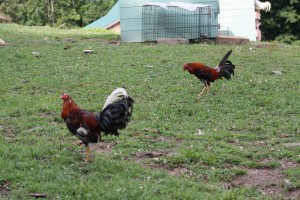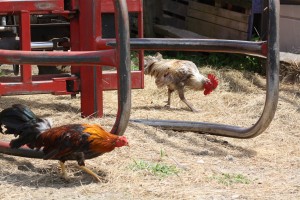Two fighters enjoying their time out of their cages
For those readers who may not know it, about a month ago, VINE took in 17 fighting roosters from three different raids in Ohio. Farm Sanctuary was kind enough to transport them to us.
Almost all the roosters who came here were veterans of the ring. Their legs and chests were plucked (and, we suspect, doused with a chemical of some kind that would inhibit future feather growth), their combs were shaved off, and they had the overall bearing of roosters who’ve been fought. Three, however, had full combs and no plucked skin, so we suspect they were either bait birds used to train the fighters or else too young to have been thrown into the ring yet.
Before I tell you how they’ve been doing, let me give you a tiny crash-course on rooster rehab, VINE-style.
Twice a day, the roosters experience “active” rehabilitation, which means they are let out of the cages in supervised fashion by VINE workers who then place them back into their cages if they fight. The rest of the day they engage in “passive” rehabilitation (not to be interpreted as less important, however), in which they watch the other folks who live up on the hill do their thing (roosters, geese, ducks, sheep, and a calf for now, as the other 31 cows are in the back pastures for the summer).
By observing them, the fighters learn that they don’t have to fight — that chickens living in non-combative environments do not solve conflicts by killing each other — and that, moreover, they might just be able to cultivate bonds with other birds, something that is inconceivable to fighters who are, after all, brainwashed into violence.
Check out this video and this webpage for more on VINE’s method of fighting cock rehabilitation.
This time around, we readied ourselves for a long rehabilitation process. We’ve never once met a rooster we could not help — never once met a rooster who could not be rehabilitated and learn to live among other birds — but given the condition in which these guys arrived, we figured we’d be in for a long ride.
Having said that………
We are thrilled to announce that two of the roosters are already completely rehabilitated! This means we can let them out in the morning and not worry about them all day. They are forming relationships with other roosters and generally settling in quite nicely. Five more are quite close to done, which means that when we let them out of their cages, they are out for a good long time (at least an hour and in most cases five or six hours) before engaging in a fight with another rooster. Seven more are doing pretty darn well, but they will just need a bit more time than the rest.
Here’s a picture of one of the new roosters hanging out with his new friend. The fighter is on the right and the non-fighter is on the left. (The non-fighter, incidentally, came from a homeless camp in New Jersey that was being shut down by law enforcement officials.) These two have been inseparable, whether or not the fighter is in his cage, almost since the first day the new roosters arrived. Relationships like this give the lie to the popular (mis)conception that roosters cannot be friends with each other. The fighter in this photo is very close to done with his rehabilitation process.
Here’s another photo of a fighter (on the left) doing what I think of as the rooster version of parallel play with another one of the five roosters who came here from the homeless camp. The fighter here is done with his process and enjoys freedom all day long.
One final note. You might be asking why these guys don’t have names. That’s because WE WANT YOU TO NAME THEM! Stay tuned to our Facebook page for more information about that. For now, I’ll say goodbye because it’s time to head back up the hill for another round of rooster rehabilitation. Sitting on a rock, watching all kinds of non-human folks do their thing with the green hills and blue skies of Vermont surrounding me, feeling moved beyond belief when I watch these previously tortured, abused, and brainwashed individuals become a little less scared every day — learn how to be happy just a little more each day — all I can think is what an amazing experience this is for us all. Especially for them.







For all of the cockfighting proponents who have been posting outraged comments, we understand that your sense of the world requires you to believe that these male birds are inherently aggressive. In the real world, Jungle Fowl (the birds to whom the birds you call game cocks are most closely related and from which all chickens descend) live together in mixed-sex flocks, cooperating to preserve the survival of the group. If what you believed were true –that males fight to the death (leaving themselves and the flock vulnerable to predation as they engage in protracted bloody battles) any time they see each other– the species never would have survived and there would be no chickens. You can read more about our procedures, as well as our interpretation of why you believe the bizarre things you do, here: http://vine.bravebirds.org/projects/rooster-rehab/
Cockfighters know very well that roosters often try to avoid fighting by fleeing, a perfectly sensible and useful response in nature. At cockfights, birds who try to flee are forced back into the fray. These unsocialized and terrified birds are often injected with testosterone or amphetamines, to heighten the likelihood that they will fight.
If this was true, then the men who force roosters to fight would not have to drug them, brainwash them, half starve them, outfit them with razor knives, shear off their combs and wattles, pluck their chest feathers, and do other horrific things to them to MAKE them fight. No! They would just “fight naturally” like you people keep saying they do.
And please don’t rush to tell me how nicely these birds are treated. Save your breath. With every word you say here, you’re lying, not just to us but probably also to yourselves, just so you don’t have to hate what sickeningly violent people you are.
Shame on all of you.
The only ones who can’t see this are the men who are so caught up in their fantasies of “cocks” as pure, aggressive, masculine energy that they sincerely cannot see the grievous injuries they are doing to birds who (in some instances) they claim to love or at least admire. If such men were truly interested in seeing the birds (and the world) more clearly, dialogue might be possible. But the tenor of the comments they post make it clear that they are interested only in sneeringly insisting that their absurd ideas about these birds are self-evidently true.
Guys, don’t bother. We won’t be giving you a platform from which to spout the sexist lies that have led so many innocent male birds to be sacrificed in the service of stereotyped ideas about masculinity.